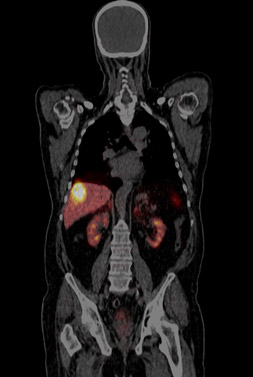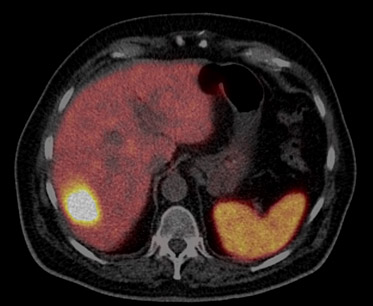Ga-68 tracers
Karina Højrup Vase, May 2016
Gallium-68 has been produced at Department of Nuclear Medicine & PET-Centre since 2010.
Gallium-68, with a half-life of 68 minutes, is produced from a Ge-68/Ga-68 generator and in this way it differs from our other PET radioisotopes, which are produced on-site by a cyclotron. Ga-68 is eluted from the generator in dilute hydrochloride acid solution (0.1 M) and is pre-purified by either acetone/HCl based solution or the less harsh NaCl/HCl solution, which eliminates the presence of organic solvents during the labelling reaction. Being a metal, a totally different radio-labelling chemistry is applied for Ga-68 compared to our other PET isotopes. Labelling with Ga-68 typically involves complexation of the metal Ga-68 ion in a bifunctional chelator containing a strong metal-chelator at one end and a linker at the other attached to the biologically active targeting molecule.
We use different bifunctional chelators such as DOTA, NOTA, and DTPA in combination with different peptides and thereby aim at different molecular targets such as receptor-specific, inflammatory markers etc. and we evaluate the radio-labelled biomolecule pre-clinically in vivo. For instance, a 68Ga-labelled antibody targeting arthritis, several 68Ga-labelled peptides targeting alphasynuclein aggregates, and recently dodecapeptides, e.g. 68Ga-A9-K-DOTA, targeting bone infections induced by staphylococcus aureus has been developed. In contract? research new compounds for imaging neuroendocrine tumours were tested.

Fig 1: Pre-clinical in vivo evaluation of a possible radiotracer for infection; PET/MRI image of 68Ga-A9-K-DOTA of a mouse with subcutaneously induced staphylococcus aureus infection.
In our routine clinical practice we use 68Ga-DOTANOC and 68Ga-DOTATOC for the imaging of somatostatin receptors in neuroendocrine tumours. Recently, 68Ga-PSMA for the imaging of prostate-specific membrane antigen in prostate cancer has been included to our routine productions for clinical use.


Fig 2: PET-CT scan with 68Ga-DOTANOC on a subject with neuroendocrine tumor.